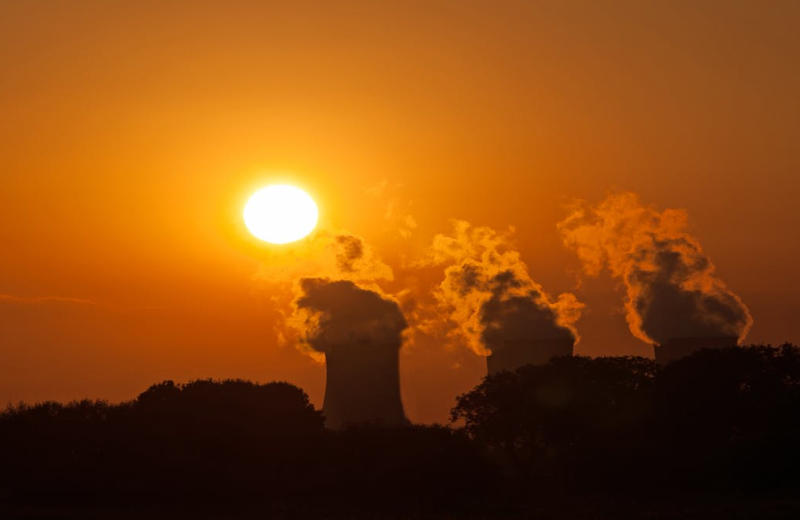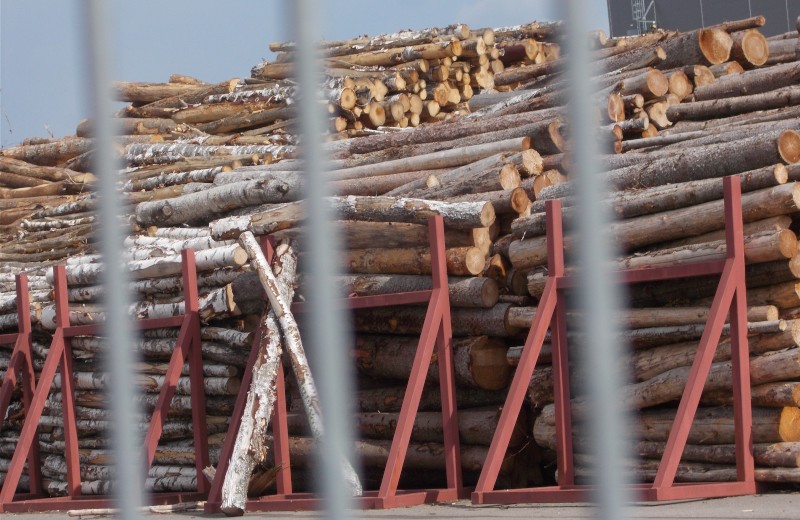Table of Contents
Burning wood releases CO2 quickly – forest growth recovers it slowly
The rationale for burning wood for heat and power is based on the assumption that newly planted vegetation will absorb an equivalent amount of carbon dioxide through photosynthesis than is released in combustion. Given certain conditions, and over an indefinite timescale this is a fair assumption. Quite clearly, plant growth is renewable in the sense that it regrows. And the magic of photosynthesis means that, in the presence of sunlight and water, plants will store carbon in their canopies and trunks as well as in their roots and in the soil – as well as being “the lungs of the world” forests are a huge carbon sink. The IPCC definition of a renewable energy, however, is more nuanced:
"Any form of energy from solar, geophysical or biological sources that is replenished by natural processes at a rate that equals or exceeds its rate of use"
The problem with burning wood for energy is well summarised by Professor Bill Moomaw, a former IPCC coordinating lead author:
"Biomass…is a high carbon emitting renewable source that can be collected and burned at a more rapid rate than it is replaced."
For the same energy output, wood releases more CO2 than coal when burned
And because wood is much less energy dense even than coal, and contains higher quantities of moisture and less hydrogen, it generally emits more carbon dioxide (as well as other harmful greenhouses gases) at the point of combustion than fossil fuels – per KWh of energy.[i] It is not correct – as is often argued – that young trees and plants sequester more carbon than older ones[iv] – and although some species of energy crops do sequester carbon from the atmosphere at an impressive rate, their potential for long term storage is much more limited[v].
Of course, all organic matter still emits carbon when it dies or decays but – importantly – at a much slower rate. Dr Mary Booth, who has published a huge amount of data on the subject of forest biomass put it this way in a 2019 article[vi]:
"If in year one, you burn 10 tons of wood pellets, you put 10 tons of carbon into the atmosphere…If it were rotting, only a fraction would decompose [over that same period]. You are comparing two pots of carbon without taking the timeline into consideration."
This concept of “carbon debt” and “carbon payback”, which was originally developed by Bill Moomaw, was echoed in September 2019 in an influential paper by the European Academies Science Advisory Council (EASAC)[vii]:
"The classification of forest biomass as ‘renewable’ is based on the reasoning that, since biomass carbon came from atmospheric CO2 and regrowth absorbs CO2 over time, it can be regarded as ‘carbon neutral’ with net emissions over the harvesting/regrowth cycle of zero. The ‘carbon neutrality’ concept is, however, a gross misrepresentation of the atmosphere's CO2 balance since it ignores the slowness of the photosynthesis process which takes several decades for trees to reach maturity."
The IPCC itself – based on hundreds of scientific studies – classifies wood burning as being around 18 per cent more emissions-intensive than bituminous coal (the most common type of coal used for power generation) in terms of kg of CO2 per TJ.[viii]
Drax power plant, in the UK
To give a specific example, the Drax power plant in the UK (which opened in 1974 and is nearing the end of the process of converting from coal to wood burning) reports its 2019 emissions from the chimney as being 12.8 MtCO2e. On calculations made by the coal-specialist think tank Ember, this means that Drax’s direct (stack) emissions from burning wood are higher than those for the coal it has replaced. (955gCO2e per kWh; higher than the emissions from coal, which were 898gCO2e per kWh in 2018[ix]). These emissions enter the atmosphere immediately. Researchers looking into the specific forest feedstock that Drax imports to the UK from Mississippi and Louisiana have estimated that it would take over 40 years before new forest growth in managed forests can restore lost carbon stocks from harvesting as well as re-absorbing the emissions Drax creates from burning wood.[x]
A lot depends on the type of biomass feedstock used and the assumptions made about what would happen to forests in the absence of the income stream now created by biomass subsidies. As Duncan Brack summarised it in a comprehensive 2017 study for Chatham House:
The many attempts that have been made to estimate carbon payback periods suggest that these vary substantially, from less than 20 years to many decades and in some cases even centuries. As would be expected, the most positive outcomes for the climate, with very low payback periods, derive from the use of [saw]mill residues (unless they are diverted from use for wood products). If forest residues that would otherwise have been left to rot in the forest are used, the impact is complex, as their removal may cause significant negative impacts on levels of soil carbon and on rates of tree growth.
The most negative impacts involve increasing harvest volumes or frequencies in already managed forests, converting natural forests into plantations or displacing wood from other uses.[xi]
As Brack notes, this was acknowledged by the European Commission in 2016, in the impact assessment it published alongside proposals to update the EU Renewable Energy Directive (under which biomass is considered a renewable fuel) although it was not substantially reflected in the final legislation that appeared in 2018.
The world needs annual emissions savings of over 7 per cent every year to stay under 1.5 degrees of warming
It should hardly need noting that waiting decades for the carbon emitted in a single year to be reabsorbed by new forest growth does not meet the timescales for greenhouse gas emissions reductions required by the Paris Agreement. In 2019, ahead of the COP25 meeting in Madrid, the UN Environment Programme estimated that global emissions needed to fall by an average of over 7 per cent every year over the next decade in order to have a good chance of keeping global average temperature rises to under 1.5 degrees C[xii]. It may be the case that the world will exhaust its remaining 1.5 degree “carbon budget” in 5-7 years from now. So any emissions reduction technology needs to be “fast acting”.
In January 2019, the EU’s Joint Research Centre reported that ‘energy produced from biomass represented 59 per cent of the EU’s renewable energy consumption in 2016[xiii].
Given what is known about the problems with burning wood for energy, why is the industry still forecast to grow so much in Europe and beyond?
The problems of “missing emissions” in carbon accounting
The answer lies, very largely, in a “carbon accounting loophole” that allows the hundreds of megatons of CO2 emitted by wood burning to be “disappeared” as wood pellets are traded between countries.
Under the Kyoto Protocol, to avoid double counting, it was agreed that the emissions from all wood harvesting would be recorded under the land use sector rather than the energy sector to avoid those from wood burned for energy being counted both under harvesting and again under energy. This contrasts with the position for fossil fuels where all emissions are recorded in the energy sector. Countries that import wood pellets for burning are, therefore, able to record their combustion emissions from pellet burning as zero (despite the fact that these are often greater than those from the fossil fuels they are displacing) on the basis that the emissions will be counted by the country harvesting the wood under their land use sector. It is true that importers are obliged to account for the emissions associated with processing and transport, however – although these are much smaller.
The problem is that several of the largest exporters of wood pellets (e.g. the US, Canada, Russia and Japan) are not parties to the second commitment period of the Kyoto Protocol (2013-2020) and so do not need to account for emissions from wood pellets at all. They are effectively lost in the system – or “disappeared”, enabling importing countries to crow about emissions reductions when there is every chance that burning pellets is in fact increasing global emissions.
Even when an exporting country is a party to the Kyoto Protocol, emissions can still disappear – as the “business as usual” baselines for forestry emissions chosen by countries generally include quite a high proportion of biomass harvesting for energy. These do not have to be accounted for either as they form part of the baseline scenario from which countries aim not to increase emissions.
Thinning or clear-cutting?
The truth is that very little is known about the replacement growth rates and carbon storage rates of forests that have been harvested for bioenergy. What is known is that very often whole trees (called ‘roundwood’) are felled and whole sections of forests clear-cut (all trees are cleared from a stand and replanted) to provide fuel for power stations[xiv]. When pellet manufacturers talk about thinning forests, they are generally talking about cutting down and removing trees – ostensibly to increase short term growth. The dynamics of forests are complex but one most not confuse sensible forest management to increase growth, carbon stocks and biodiversity with subsidy-driven incentives to thin forests for bioenergy.
All this is, of course, before we add the emissions associated with shipping millions of tons of biomass across the Atlantic for use in Europe.
Duncan Brack’s work for Chatham House[xv] suggested that – all together – 217.65 Mt of CO2 could be going unaccounted for. This is not far off two thirds of the total annual emissions of a large emitter like the UK [xvi] and it is set to grow if projections for biomass demand for power and heat are borne out.
Endnotes
[i] Although a wonder of nature, the photosynthesis process is nowhere near as “efficient” as modern photovoltaic cells are at converting sunlight into energy. Glucose-based plant energy then needs to be burned to generate heat and power, while PV cells generate electricity directly. Intergovernmental Panel on Climate Change (2006). “Table 2,” Guidelines for National Greenhouse Gas Inventories, Vol. 2 (Energy), pp 2.16-2.17. Available online at: https://tinyurl.com/wbprapc
[iv] Stephenson, N., Das, A., Condit, R. et al. Rate of tree carbon accumulation increases continuously with tree size. Nature 507, 90–93 (2014). https://doi.org/10.1038/nature12914
…for most species, mass growth rate increases continuously with tree size. Thus, large, old trees do not act simply as senescent carbon reservoirs but actively fix large amounts of carbon compared to smaller trees; at the extreme, a single big tree can add the same amount of carbon to the forest within a year as is contained in an entire mid-sized tree .
[v] Lewis et al “Restoring natural forests is the best way to remove atmospheric carbon” Nature 568, 25-28 (2019): doi:10.1038/d41586-019-01026-8
[vi] Mary Booth “UN and policymakers, wake up! Burning trees for energy is not carbon neutral (commentary)” Mongabay 16 September: https://bit.ly/3fhS2xd
[vii] Norton, M, Baldi, A, Buda, V, et al. Serious mismatches continue between science and policy in forest bioenergy. GCB Bioenergy. 2019; 11: 1256– 1263. https://doi.org/10.1111/gcbb.12643
[viii] Intergovernmental Panel on Climate Change (2006). Guidelines for National Greenhouse Gas Inventories, (Energy), https://bit.ly/2AlqsR5 See in particular Ch2 Table 2.2
[ix] This is based on Drax generating 13.4 TWh of energy from biomass in 2019. Ember (2019) “The Burning Question”. Drax Annual Report and Accounts (2019) p.39 https://bit.ly/31GW1zm
[x] Spatial Infographics Group (2019): https://bit.ly/3cYdIgc – Shorter (4-page) fact sheet based on the report is here: https://bit.ly/39tYKgz
[xi] Duncan Brack, ‘The Impacts of the Demand for Woody Biomass for Power and Heat on Climate and Forests’ Chatham House (2017): https://bit.ly/2AnIq5s
[xii] United Nations Environment Programme (2019). Emissions Gap Report 2019. UNEP,
: https://www.unenvironment.org/resources/emissions-gap-report-2019
[xiii] European Commission: Facts and figures on bioenergy in the EU (Jan 2019): https://bit.ly/3jwbY1C
[xiv] See pictures from Dogwood Alliance (2019),and Stand.earth (2020)
[xv] Ibid. Brack 2017
[xvi] The UK’s CO2 emissions in 2019 were estimated at 354 million tonnes of CO2 (MtCO2)https://www.ipcc.ch/site/assets/uploads/2018/03/Annex-I-Glossary-Acronyms-Chemical-Symbols-and-Prefixes-1.pdf





